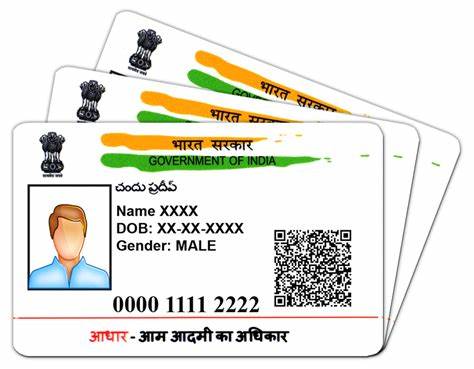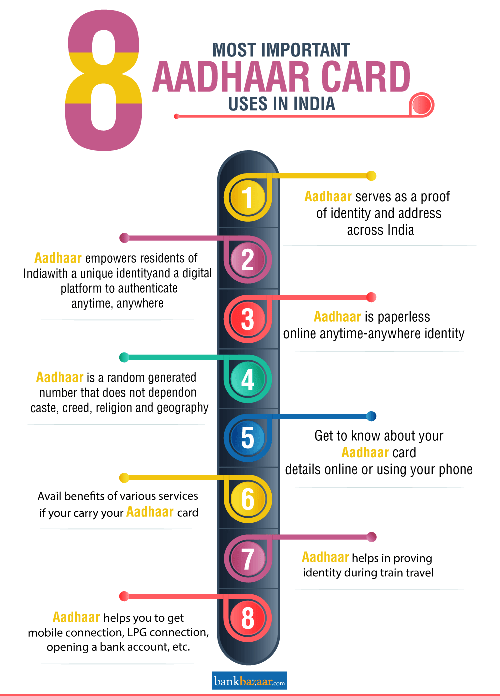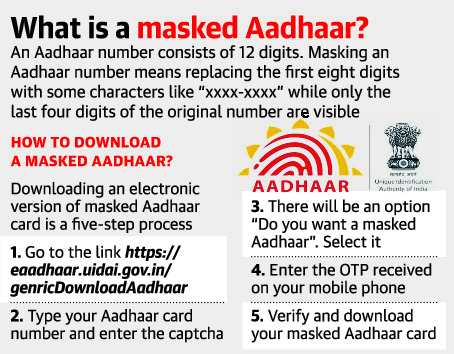Description

Disclaimer: Copyright infringement not intended.
Context
- Earlier, the Ministry of Electronics & Information Technology (MeitY) had cautioned citizens against sharing a photocopy of their Aadhaar card with any organisation as it can be misused.
- But now Govt. has withdrawn the advisory shared earlier, about not sharing photocopies of Aadhaar card. However, they have advised that only a masked copy of Aadhaar can be used, which shows only last 4 characters.
About Aadhaar
- The Aadhaar card is a 12-digit unique number issued by the Unique Identification Authority of India (UIDAI).
- It contains biometric information, such as fingerprints and iris scans, along with demographic information, including individuals’ addresses and date of birth.
- The Aadhaar card serves as proof of identity and is valid anywhere in India for any identification purposes. Having an Aadhaar card is compulsory while applying for a new PAN card or filing Income tax returns.
Essential Facts about the Aadhaar Card
- Indians and NRIs can apply for an Aadhaar Card. However, according to the Aadhaar act 2016, any individual must stay in India for 182 days or more in the year immediately preceding the date of enrolment application.
- The UID number of the Aadhaar card is unique for each individual and remains valid for them for a lifetime.
- Aadhaar enrolment is completely free from any charges.
- In the case of multiple enrolments, only one Aadhaar number is generated, while others are dismissed as duplicates.
- UIDAI offers several online services like checking Aadhaar enrolment status, updating address, locking/unlocking biometric details, etc.
- Cardholders can download a digital copy of their Aadhaar card to use for various government verifications.
|
Demographic information
|
Name, Date of Birth (verified) or Age (declared), Gender, Address, Mobile Number (optional) and Email ID (optional), in case of Introducer-based enrolment- Introducer name and Introducer’s Aadhaar number, in case of Head of Family based enrolmen- Name of Head of Family, Relationship and Head of Family’s Aadhaar number; in case of enrolment of child- Enrolment ID or Aadhaar number of any one parent, Proof of Relationship (PoR) document
|
|
Biometric information
|
Ten Fingerprints, Two Iris Scans, and Facial Photograph
|
Aadhaar number is devoid of any intelligence and does not profile people based on caste, religion, income, health and geography. The Aadhaar number is a proof of identity, however, it does not confer any right of citizenship or domicile in respect of an Aadhaar number holder.
Eligibility Criteria for Aadhaar Card
- Any Indian resident irrespective of his/her gender and age can enrol for an Aadhaar card.
- As per the Aadhaar Act 2016, Indian citizens need to reside in the country for 182 days or more in the year preceding the date of enrolment.
- Non-resident Indians (NRIs) and Overseas Citizens of India (OCI) are not eligible for an Aadhaar card. If NRIs and foreigners satisfy the minimum duration of stay as per the aforementioned Act, they can apply for an Aadhaar card.
- Minors, too, can apply for the Aadhaar Card. Children under the age of 5 will get the Blue Colour Aadhaar, which needs to get updated after they become 5 years old.

Significance
- Aadhaar is a strategic policy tool for social and financial inclusion, public sector delivery reforms, managing fiscal budgets, increase convenience and promote hassle-free people-centric governance.
- Aadhaar identity platform with its inherent features of Uniqueness, Authentication, Financial Address and e-KYC, enables the Government of India to directly reach residents of the country in delivery of various subsidies, benefits and services by using the resident’s Aadhaar number only.
- Aadhaar number is verifiable in an online, cost-effective way. It is unique and robust enough to eliminate duplicates and fake identities and may be used as a basis/primary identifier to roll out several Government welfare schemes and programmes for effective service delivery thereby promoting transparency.
What is Masked Aadhaar?
- Masked Aadhaar is similar to a regular Aadhaar with a difference that the Aadhaar number is partially hidden.
- Only last four digits of the Aadhaar number are visible and the rest are crossed.
- It basically means replacing the first eight digits with some characters like "xxxx-xxxx" while only the last four digits of the original number are visible
- Other details in the Aadhaar card remains the same such as the name, date of birth, gender, address and the QR code.
- One can download Aadhaar card easily online.

In a nutshell,
- Masked Aadhaar is an offline verification system that can be used by the holder without revealing his/her 12-digit number or giving biometric details for services. It can be dowloaded from UIDAI website and has only your name, address, photo and virtual ID.
- The QR Code, which can be downloaded from the UIDAI website, contains demographic information and photograph of the resident, but not the Aadhaar number. In addition, the information in QR code is made secure and tamper-proof with UIDAI digital signatures. This too can be used for services if the service provider has QR code reader application downloaded from the UIDAI website.
- However, the masked Aadhaar or QR Code form of identification cannot be used for government welfare schemes such as LPG subsidy, pension or Ayushman Bharat because that requires beneficiaries to furnish their full Aadhaar details and undergo authentication.
Centre retracts caution on Aadhaar photocopies - The Hindu
1.png)















